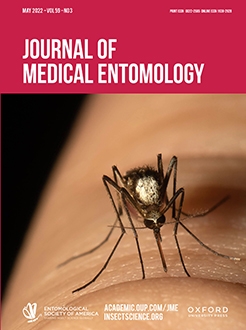Environmental conditions associated with urbanization are likely to influence the composition and abundance of mosquito (Diptera, Culicidae) assemblages through effects on juvenile stages, with important consequences for human disease risk. We present six years (2011–2016) of weekly juvenile mosquito data from distributed standardized ovitraps and evaluate how variation in impervious cover and temperature affect the composition and abundance of container-breeding mosquito species in Maryland, USA. Species richness and evenness were lowest at sites with high impervious cover (>60% in 100-m buffer). However, peak diversity was recorded at sites with intermediate impervious cover (28–35%). Four species were observed at all sites, including two recent invasives (Aedes albopictus Skuse, Ae. japonicus Theobald), an established resident (Culex pipiens L), and one native (Cx. restuansTheobald). All four are viral vectors in zoonotic or human transmission cycles. Temperature was a positive predictor of weekly larval abundance during the growing season for each species, as well as a positive predictor of rapid pupal development. Despite being observed at all sites, each species responded differently to impervious cover. Abundance of Ae. albopictus larvae was positively associated with impervious cover, emphasizing that this medically-important vector not only persists in the warmer, impervious urban landscape but is positively associated with it. Positive temperature effects in our models of larval abundance and pupae occurrence in container habitats suggest that these four vector species are likely to continue to be present and abundant in temperate cities under future temperature scenarios.
How to translate text using browser tools
7 April 2022
Changes in Container-Breeding Mosquito Diversity and Abundance Along an Urbanization Gradient are Associated With Dominance of Arboviral Vectors
MyKenna Zettle,
Elsa Anderson,
Shannon L. LaDeau
ACCESS THE FULL ARTICLE
It is not available for individual sale.
This article is only available to subscribers.
It is not available for individual sale.
It is not available for individual sale.

Journal of Medical Entomology
Vol. 59 • No. 3
May 2022
Vol. 59 • No. 3
May 2022
arthropod
biodiversity
urban
virus





